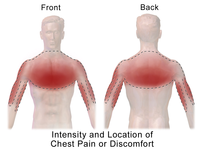
Teriparatide rapidly improves pain-like behavior in ovariectomized mice in association with the downregulation of inflammatory cytokine expression
Sign Up to like & getrecommendations! Published in 2017 at "Journal of Bone and Mineral Metabolism"
DOI: 10.1007/s00774-017-0865-0
Abstract: Recent studies have indicated that teriparatide, an anti-osteoporosis agent, significantly improves back pain regardless of the presence of vertebral fracture in osteoporosis patients. The aims of this study were to examine whether teriparatide improves pain-like… read more here.
Keywords: pain like; inflammatory cytokine; like behavior; expression ... See more keywords

An Omega-3-rich Anti-inflammatory Diet Improved Widespread Allodynia and Worsened Metabolic Outcomes in Adult Mice Exposed to Neonatal Maternal Separation
Sign Up to like & getrecommendations! Published in 2021 at "Neuroscience"
DOI: 10.1016/j.neuroscience.2021.06.001
Abstract: Inflammation plays a key role in the progression and maintenance of chronic pain, which impacts the lives of millions of Americans. Despite growing evidence that chronic pain can be improved by treating underlying inflammation, successful… read more here.
Keywords: anti inflammatory; pain like; maternal separation; neonatal maternal ... See more keywords

Batatasin III, a Constituent of Dendrobium scabrilingue, Improves Murine Pain-like Behaviors with a Favorable CNS Safety Profile.
Sign Up to like & getrecommendations! Published in 2022 at "Journal of natural products"
DOI: 10.1021/acs.jnatprod.2c00376
Abstract: Batatasin III is a stilbenoid compound present in a wide variety of Dendrobium species. Although the pharmacological efficacy of batatasin III has been reported in several disease models, its antinociceptive efficacy and central nervous system… read more here.
Keywords: like behaviors; batatasin iii; cns safety; batatasin ... See more keywords

Neuropeptide Y in the amygdala contributes to neuropathic pain-like behaviors in rats via the neuropeptide Y receptor type 2/mitogen-activated protein kinase axis
Sign Up to like & getrecommendations! Published in 2022 at "Bioengineered"
DOI: 10.1080/21655979.2022.2051783
Abstract: ABSTRACT Neuropeptide Y (NPY) is a highly conserved endogenous peptide in the central and peripheral nervous systems, which has been implicated in nociceptive signaling in neuropathic pain. However, downstream mechanistic actions remain uncharacterized. In this… read more here.
Keywords: like behaviors; amygdala; neuropathic pain; pain like ... See more keywords

Pain-like behavior in mice can be induced by the environmental context in which the pain stimulus was previously given
Sign Up to like & getrecommendations! Published in 2021 at "NeuroReport"
DOI: 10.1097/wnr.0000000000001607
Abstract: It has been known for decades that classical conditioning influences pain perception. However, the precise mechanism of pain modified by conditioning remains unclear, partly because of the lack of dedicated behavioral tests. In the present… read more here.
Keywords: pain stimulus; pain; context pain; like behavior ... See more keywords

Role of T CD4+ cells, macrophages, C‐low threshold mechanoreceptors and spinal Cav3.2 channels in inflammation and related pain‐like symptoms in murine inflammatory models
Sign Up to like & getrecommendations! Published in 2022 at "British Journal of Pharmacology"
DOI: 10.1111/bph.15956
Abstract: T‐type calcium channels, mainly the Cav3.2 subtype, are important contributors to the nociceptive signalling pathway. We investigated their involvement in inflammation and related pain‐like symptoms. read more here.
Keywords: related pain; like symptoms; pain like; inflammation related ... See more keywords

Pharmacological Ischemic Conditioning with Roxadustat Does Not Affect Pain-Like Behaviors but Mitigates Sudomotor Impairment in a Murine Model of Deep Hind Paw Incision
Sign Up to like & getrecommendations! Published in 2023 at "Journal of Pain Research"
DOI: 10.2147/jpr.s397054
Abstract: Purpose The involvement of hypoxic response mechanisms in local functional impairments in surgical wounds is unclear. In the present study, we characterized tissue hypoxia in surgical wounds and investigated the role of pharmacological ischemic conditioning… read more here.
Keywords: pic; incision; pharmacological ischemic; pain ... See more keywords